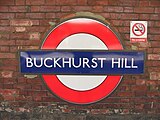Buckhurst Hill Tube Station
History

The station opened on 22 August 1856 as part of the Eastern Counties Railway branch from London to Loughton. It originally had staggered platforms, with the main buildings on the down side (tracks heading away from London). The 1856 station house survives to the south of the present platforms, but most of the present station dates from 1892, when the entrance was moved to Victoria Road. The building is similar to that at Billericay. Both were designed by W. N. Ashbee, the chief architect of the Great Eastern Railway, of which the station was a part, which was, from 1923, to become part of the London and North Eastern Railway.
The station was transferred to London Underground ownership as part of the New Works Programme, 1935-1940 scheme that saw the electrification of the branch to form part of the Central line. This occurred on 21 November 1948. The station maintains its late Victorian ambiance to a surprising extent.
When the line was electrified a pedestrian underpass was built in order to connect the two parts of Queens Road previously joined by a level crossing. At the same time a pair of exit/entrances to the south of the station were built giving direct access to Lower Queens Road and Queens Road via the new underpass. These exits were closed in 1982, but reopened in May 2018 in order to provide access to the station for mobility impaired passengers.
For the purposes of fare charging it is in Zone 5. As of 2007 it is the only station on the eastern portion of the Central line in that zone. Passengers travelling from the station leaving in either direction must cross a zone boundary.
Gallery
-
The station today
-
Looking north
-
Looking south
-
Looking south from the footbridge
-
Looking north from the footbridge
-
Roundel
References
- ^ Standard Tube Map (PDF) (Map). Not to scale. Transport for London. April 2024. Archived (PDF) from the original on 28 May 2024. Retrieved 3 June 2024.
- ^ "Station Usage Data" (XLSX). Usage Statistics for London Stations, 2019. Transport for London. 23 September 2020. Archived from the original on 9 November 2020. Retrieved 9 November 2020.
- ^ "Station Usage Data" (XLSX). Usage Statistics for London Stations, 2020. Transport for London. 16 April 2021. Retrieved 1 January 2022.
- ^ "Station Usage Data" (XLSX). Usage Statistics for London Stations, 2021. Transport for London. 12 July 2022. Retrieved 7 September 2022.
- ^ "Station Usage Data" (XLSX). Usage Statistics for London Stations, 2022. Transport for London. 4 October 2023. Retrieved 10 October 2023.
- ^ "Station Usage Data" (XLSX). Usage Statistics for London Stations, 2023. Transport for London. 8 August 2024. Retrieved 16 September 2024.
- ^ Hardy, Brian, ed. (March 2011). "How it used to be – freight on The Underground 50 years ago". Underground News (591). London Underground Railway Society: 175–183. ISSN 0306-8617.
- ^ Kay, Peter (2006). Essex Railway Heritage. Wivenhoe UK: Peter Kay. pp. 28–29. ISBN 978-1-899890-40-8.
External links
- http://citytransport.info/BuckhurstHill.htm – Photographs of the Victorian era station platforms, shelters and waiting rooms.
| Preceding station | Following station | |||
|---|---|---|---|---|
| Woodford towards Ealing Broadway or West Ruislip
|
Central line Epping branch
|
Loughton towards Epping
| ||
| Historical railways | ||||
| Woodford Line and station open |
Great Eastern Railway Eastern Counties Railway Loughton branch |
Loughton Line and station open | ||





